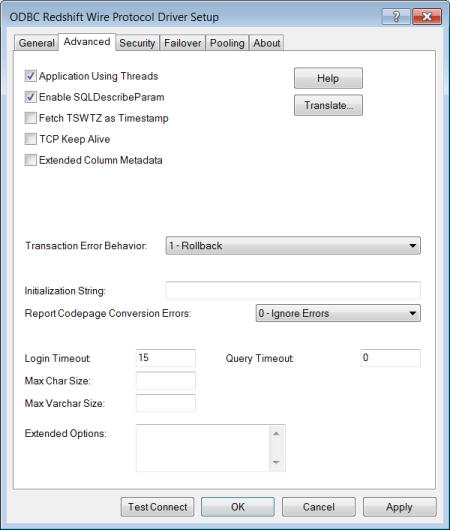
|
Connection Options: Advanced
|
Description
|
|
Determines whether the driver works with applications using multiple ODBC threads.
If enabled, the driver works with single-threaded and multi-threaded applications.
If disabled, the driver does not work with multi-threaded applications. If using the driver with single-threaded applications, this value avoids additional processing required for ODBC thread-safety standards.
Default: Enabled
|
|
|
Determines whether SQLDescribeParam returns the Datatype, ParameterSize, DecimalDigits, and Nullable information for parameters in a prepared statement.
If enabled, SQLDescribeParam returns the Datatype, ParameterSize, DecimalDigits, and Nullable information for parameters in a prepared statement.
If disabled, the driver does not support SQLDescribeParam and returns the message: Driver does not support this function.
Default: Enabled
|
|
|
Determines whether the driver returns column values with the timestamp with time zone data type as the ODBC data type SQL_TYPE_TIMESTAMP or SQL_VARCHAR.
If enabled, the driver returns column values with the timestamp with time zone data type as the ODBC type SQL_TYPE_TIMESTAMP. The time zone information in the fetched value is truncated. Use this value if your application needs to process values the same way as TIMESTAMP columns.
If disabled, the driver returns column values with the timestamp with time zone data type as the ODBC data type SQL_VARCHAR. Use this value if your application requires the time zone information in the fetched value.
Default: Disabled
|
|
|
Specifies whether the driver enables TCPKeepAlive.
If disabled, the driver does not enable TCPKeepAlive.
If enabled, the driver enables TCPKeepAlive.
Default: Disabled
|
|
|
Determines how the driver returns column metadata when using SQLDescribeCol and SQLColAttribute. For more information, see "Extended Column MetaData."
Default: Disabled
|
|
|
Determines how the driver handles errors that occur within a transaction. When an error occurs in a transaction, the Redshift server does not allow any operations on the connection except for rolling back the transaction.
If set to 0 - Do Nothing, the driver does not roll back the transaction when an error occurs. The application must handle the error and roll back the transaction. Any operation on the statement other than a rollback results in an error.
If set to 1 - Rollback, the driver rolls back the transaction when an error occurs. In addition to the original error message, the driver posts an error message indicating that the transaction has been rolled back.
Default: 1 - Rollback
|
|
|
A SQL command that is issued immediately after connecting to the database to manage session settings.
Default: None
|
|
|
Specifies how the driver handles code page conversion errors that occur when a character cannot be converted from one character set to another.
If set to 0 - Ignore Errors, the driver substitutes 0x1A for each character that cannot be converted and does not return a warning or error.
If set to 1 - Return Error, the driver returns an error instead of substituting 0x1A for unconverted characters.
If set to 2 - Return Warning, the driver substitutes 0x1A for each character that cannot be converted and returns a warning.
Default: 0 - Ignore Errors
|
|
|
The number of seconds the driver waits for a connection to be established before returning control to the application and generating a timeout error.
Default: 15
|
|
|
The number of seconds for the default query timeout for all statements that are created by a connection.
Default: 0
|
|
|
Specifies the maximum size of columns of type SQL_CHAR that the driver describes through result set descriptions and catalog functions.
Default: None
|
|
|
Specifies the maximum size of columns of type SQL_VARCHAR that the driver describes through result set descriptions and catalog functions.
Default: None
|